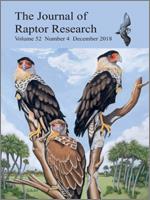Ungulate carrion supports an unusual canine-corvid-eagle winter scavenging guild in northern Arizona. To evaluate the effect of location and habitat on carcass use and longevity, between December 1996 and April 2008 we recorded 870 observations of Bald Eagles (Haliaeetus leucocephalus), Common Ravens (Corvus corax) and coyotes (Canis latrans) scavenging 123 ungulate carcasses: 103 elk (Cervus canadensis), 12 mule deer (Odocoileus hemionus), seven pronghorn antelope (Antilocapra americana), and one domestic cow (Bos taurus). Our temporal metric for measuring carcass longevity and scavenger presence was carcass-day (CD), numbered consecutively from the first day a carcass was recorded until it was consumed. We observed 38 separate carcasses (individual placement), 39 carcasses as part of three-carcass arrays in habitat associated with open, edge, and forest cover types (simultaneous choice), 22 carcasses left along the roadway where killed (monitored in place), and 24 carcasses partially skinned and/or cut open (facilitated). Elk carcasses lasted a mean 11.9 d (range 3–41), with 60% consumed during the first wk. Deer and pronghorn lasted 5.5 d (range 3–12) and 3.0 d (range 2–4), respectively. Ravens normally arrived by CD 3, Bald Eagles by CD 4, and coyotes by CD 6. Bald Eagles relied on ravens for discovery and sentinel duties, whereas both species depended on coyotes for accessibility. Winter- and road-killed carrion, not canine predation, drove carcass availability. Bald Eagles and coyotes used natural carrion more than human-influenced (road-killed or cut-open) carcasses, whereas Common Ravens were uninhibited by the latter. Removing ungulate carcasses from highway rights-of-way and partially opening them will promote quicker carcass consumption and safer avian scavenging by reducing potential for collisions with passing vehicles. A better understanding of the use of road-killed, large ungulate carrion may facilitate managing this supplemental food source as potential mitigation for other anthropogenic threats to both Bald and Golden Eagles (Aquila chrysaetos), including wind-energy development.
How to translate text using browser tools
1 December 2018
Winter Scavenging of Ungulate Carrion By Bald Eagles, Common Ravens, and Coyotes In Northern Arizona
Teryl G. Grubb,
Roy G. Lopez
ACCESS THE FULL ARTICLE

Journal of Raptor Research
Vol. 52 • No. 4
December 2018
Vol. 52 • No. 4
December 2018




